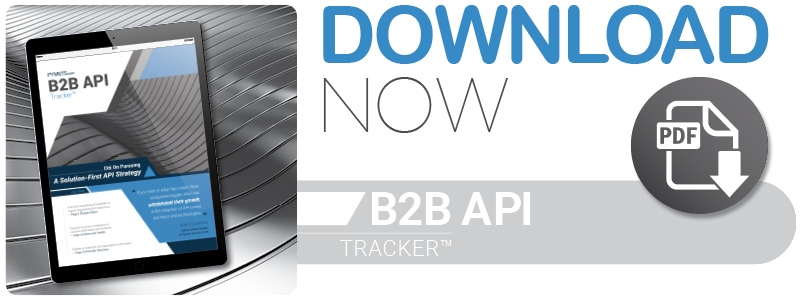Citi On Pursuing A Solution-First API Strategy

In the financial services space, it’s disrupt or be disrupted. For FIs, this means owning the disruption by developing and deploying their own API solutions in-house instead of turning to outside consultants. In the July B2B API Tracker, Rene Schuurman, global market manager of Citi’s Channel Services division, explains how developer portals are empowering FIs to embrace a DIY approach to innovation and pursue solution-first strategies.
As the old proverb goes, give a man a fish and you feed him for a day. But if you teach a man to fish, you feed him for life. In the financial services sector, APIs could be the fishing lesson banks need to thrive.
The next stage of API evolution appears to help banks and other financial institutions (FIs) understand how to respond to actionable intelligence that these solutions can provide, such as planning cash flow needs around international bank holidays. And the availability of API-generated insights is seemingly making banks and FIs more intelligent in return. By using APIs that are easy-to-integrate and highly scalable in nature, banks are able to actively play the role of disruptor in the financial services space, said Rene Schuurman, global market manager of Citi’s Channel Services division, in a recent interview with PYMNTS.
“They’re almost like Legos,” Schuurman said. “You build something, take it apart and build something new.”
Schuurman recently spoke with PYMNTS about how APIs are teaching banks to fish for themselves and prompting them to shape their own innovation agendas. The use of APIs, he said, is helping the financial services sector to own, instead of react to, the pace of disruption.
Using A Sandbox To Streamline Solutions
APIs are still a relatively new technology for the financial services space, Schuurman noted. In the past, banks have sought to partner with software vendors or consultants to help institutions implement API solutions, which often involves a more challenging approach of sharing traditional user guides. In recent years, however, Schuurman said banks have adopted more of a DIY attitude, and are eager to develop and release their own APIs at a faster pace. More recently, he added, there’s a growing demand for a more agile development process. This means easier access to API documentation so FIs can start developing solutions when they are ready.
Schuurman said FIs are realizing that if they want to offer the services and products that their customers want, they will have to take the lead, meaning they have to develop and deploy their own API solutions. To aid this effort, Citi recently launched the API Developer Portal. The purpose of the portal, Schuurman said, is to help developers access the necessary documentation when they want it, without having to wait for Citi to supply documentation and specifications.
With the developer portal available, Schuurman said, Citi no longer has to send “big email attachments” to help banks pursue their API goals. The portal’s sandbox environment also allows clients to test how APIs will work in a secure environment before deploying them. Schuurman noted that many FIs have their development teams scattered globally and that an online portal offers teams a place to centralize their efforts.
So far, the results have been encouraging. Schuurman said some of Citi’s clients have been able to complete the building and testing phase of their API developments in less than three weeks.
Faster Payments, Faster API Development
Outside of financial services, Schuurman noted that other industries have been significantly disrupted by the use of APIs. This includes the hospitality market — upended in recent years by services like KAYAK and Airbnb — and the transportation market, which has undergone its own transformation as rideshare services like Uber and Lyft gained popularity.
“If you look at what has made these companies bigger, what has accelerated their growth is adoption of API-based solutions and technologies,” Schuurman said.
Unlike the transportation and hospitality industries, which were caught off guard by new players in the market, Schuurman said banks are fully aware of the disruption underway, and want to be part of the movement. That disruption can be pointed to the rollout of faster payment systems in several global markets, including the U.K.’s Faster Payments Scheme, SEPA’s Instant Credit Transfer scheme in Europe and New Payments Platform in Australia.
As he sees it, the rise of global faster payments services means new opportunities for banks to better serve their customers. APIs make it simple for banks to offer these services while shifting away from legacy systems and older, batch-driven processes. Hence, banks are eager to invest heavily in their potential.
“I think it’s fair to say the financial services industry is in the middle of being absolutely disrupted,” he said. “Banks recognize what is driving these investments.”
As new faster payment schemes emerge in different markets, APIs will play an important role in ensuring that banks can play an active role in the space.
“APIs are truly the glue that makes everything connect together,” Schuurman added.
The Future Of Financial APIs
As payments get faster, the role of APIs is positioned to grow considerably, Schuurman said. This is because banks will look to APIs to act as turnkey solutions that can quickly help them adapt to changing payment realities. For Citi, one of those realities could include shifting toward a solution-oriented approach to APIs. That is, while many API queries are focused on collecting information like payment status or balance information, this can be converted into actionable intelligence by the same FIs.
In the cross-border payment space, for example, actionable intelligence could help FIs in different global regions remain compliant with international regulations, and more easily track important developments in overseas markets. In this type of situation, APIs can be used to inform payment recipients that they will likely not receive a payment because of a bank holiday in an overseas market, and urge recipients’ banks to plan accordingly.
Looking ahead, Schuurman sees APIs doing more than simply providing information between parties — they will also provide a roadmap to actionable intelligence that can be used to help banks find solutions to common payment frictions.
“APIs are going to be transformational,” he said. “The biggest thing we’ve observed from using APIs is it allowed us to have a solution design-thinking approach.”
With the financial services market changing rapidly, banks are realizing it pays to be able to find their own solutions to payment demands. In other words, APIs are the tools that can help them learn how to fish for themselves.

